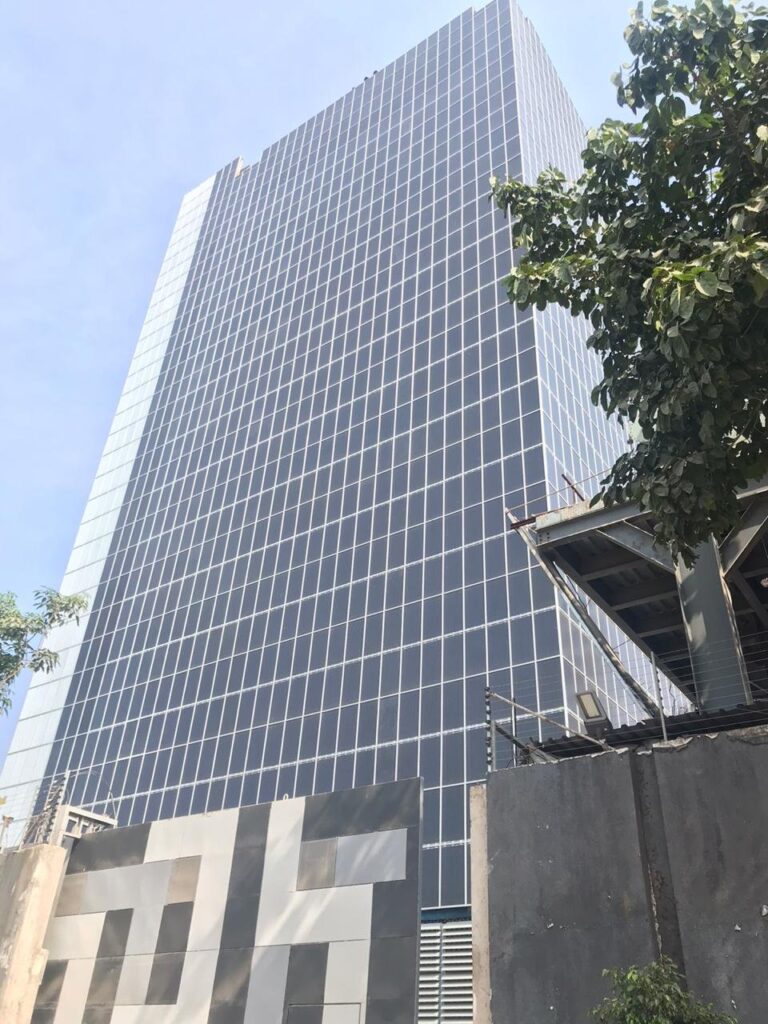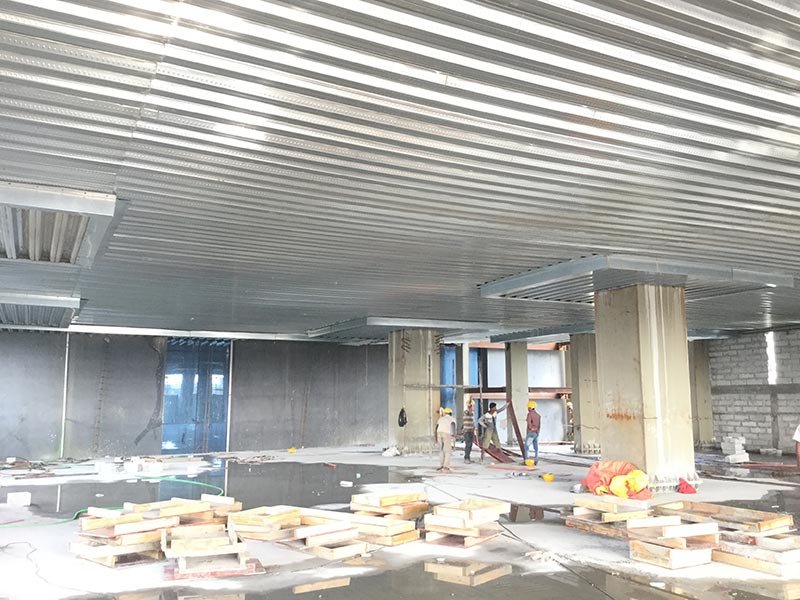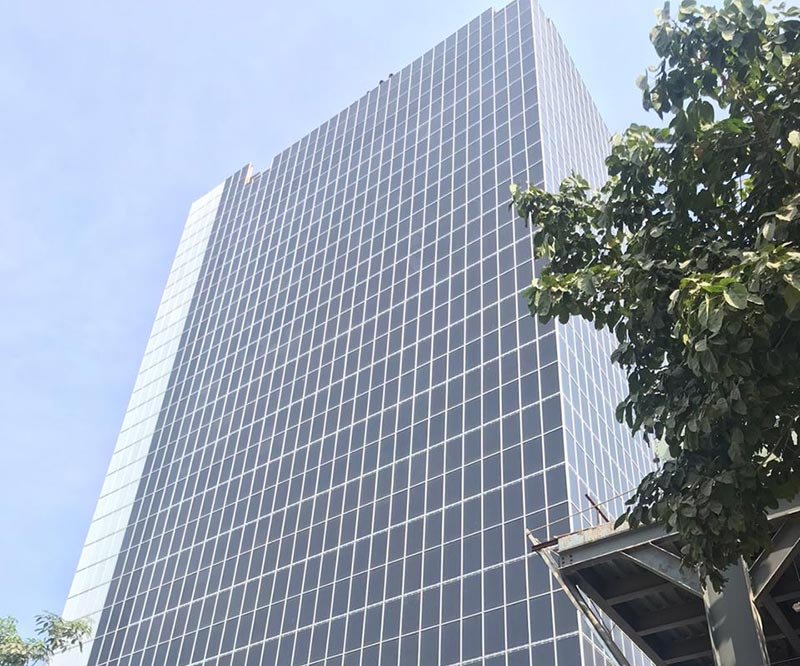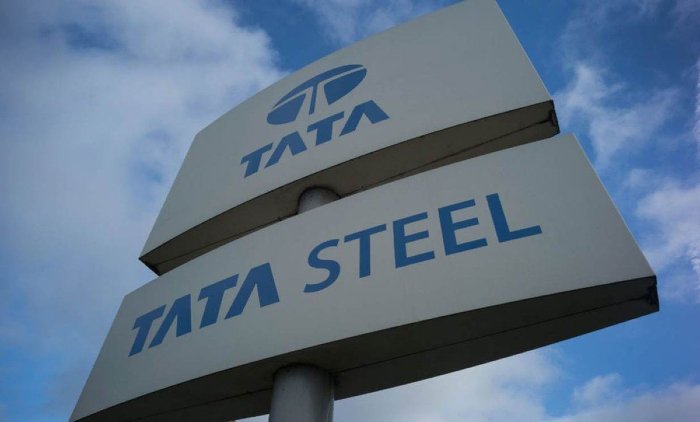Face File
Architects: PG Patki Architects
Structural Engineers: Sri Harsha Consultants Pvt Ltd
Civil Contractor : MYSR-INFRA
PEB Contractors & Steel Supplier: Kirby Building Systems & Structures India Pvt Ltd
Steel Tonnage: 2070 Tonnes
Data Centre, Mumbai
Date Centre consists of huge boxes called racks of size 600mm x 1200mm which resembles CPU of a regular computer, used for the storage of information. These racks are kept systematically in rows and aisles. The aisles are meant to walk and maintain these racks. All these racks are kept on a raised platform 1m above the regular floor. This platform is created by providing steel struts on the floor at every 600mm intervals in both the directions. On these steel struts special tiles of 600mm x 600mm are provided, which can be easily removed with a small vacuum machinery.
All the data cables will be running below this platform and fixed to the racks from below. The general racks arrangement is as shown below:
The height of each rack will be 2.4m. All the power supply to these racks will be done through the cables/ cable trays hung from the roof top.
All the AC ducts are hung from roof top through which AC and RH are controlled. In data centre which stores information for gaint companies like Microsoft, Google etc. In data centre, information storage is vital and one cannot think of power failure for even for a blink of a second.
Hence, for a data centre, electricity is taken from two feeders with two sets of transformers, two parallel ducts of AC, two sets of DG and diesel storage for a whole 7 days apart from the UPS and battery system. That means there is a pucca redundancy being maintained. To maintain all of these, they have to house lot of equipment and their foundations at GL and at various floor levels which means doing an industrial structure and putting up various utilities in a building.
Requirement
The team visited Mumbai for knowing the ground situation. They found that there is an existing building of 7 floors with a data centre running successfully and adjacent to it they had to design 12 storeyed building.

Challenges
The challenge was to design a structure by which their present operation should not get hampered. There is hardly any space left for construction material storage. To match the existing floor levels, so that in future the operations could be seamless. There is a fire sump and pump house adjacent to the existing building and they cannot afford to disturb the existing facility.
Hence, building columns had to be placed 6.5 away from existing building and provide cantilevers up to the building. The upper layer of soil was very loose, and rock was present at 6-7m from GL. With all the constraints mentioned above, the client wanted everything from start to finish in 9 months including design.
Design Parameters
The live load on regular data floors (5m floor to floor height) -1500kg /
The live load on DG and other service floors (6m floor to floor height) -1850kg/
Basic wind speed 44 m/s (for Mumbai) in accordance with – IS 875 (part3) -2015
Seismic load – Zone IV in accordance with – IS 1893 -2016
Thought Process
Initially it was thought, it could be designed with RCC PT slab. Since, the project was located in Mumbai, the engineer in-charge told that arranging RMC for such a huge quantity in such a short span of time is difficult and storing of shuttering material, steel stockyard was impossible. Hence, the thought process turned towards steel. The grid requirement was 12.5m x 9.6m. While a regular steel structure requires minimum depth of steel member could be 750mm + deck slab which will not match the floor plan. Therefore, STEEL COMPOSITE FLAT SLAB was opted, but the biggest challenge was to provide deck sheet below the steel members to create composite action. After designing everything, renowned PEB vendors were approached to execute and hence Kirby came on board to execute this project.

This data centre is Asian tallest data centre. This data centre is the only platinum rated LEED certification in data centre vertical. The client wanted to build a world class data with tier 4 category requirements. The client gave a free hand to choose the kind of structural system which enables him to lease-out the premises in a shortest possible time. We chose to do steel structure composite flat slab and achieved the timelines as per the client’s requirement. At present, some of the big players in software have already occupied and they are happy with the project and the load specifications for which we have designed. As the elevation is done completely with solar panels, it stands out and this building has become a unique in all aspects.
V. Sridhar Reddy, Managing Director, Sri Harsha Consultants Pvt Ltd

Construction Phase
The foundation was done on the rock strata which gave the confidence that the kind of load 5000T was very well addressed. Kirby provided one tower crane for height of 80m to handle a structure of 72m and a boom length of 50m and the load carrying capacity at the tip was 5T apart from this.
A mobile crane was deployed which could handle members up to 24m height. The main columns sizes were 1500mm x 1500mm (concrete filled columns) the reinforcement cage was supplied by the civil contractor at Kirby factory, cage was inserted inside the column and fixed using tack welding and then transported it to the site.
The flat slab capital portion of steel beams of size – I web 400 x 10thick + 2FLG 250 x 12 thick have also been made into two halves and transported to the site and fixed to the cleats with nut & bolts already provided to the columns. The flat slab portion of the beams of size I-web 200 x 8 + 2 FLG 200 x 10thick were also made and the beams were joined at factory transported to the site and fixed with nut and bolts. The fixing of all the required steel beams for composite flat slab the reinforcement cage was welded at the bottom and top of the steel members. The deck sheet has been pulled to the bottom of the steel member and fixed from bottom using the bullet kind of nails (of Hilti make)
The final size of composite flat slab is 494mm at capital and 294mm for flat portion of slab over and above the deck sheet (1mm thick with pitch of 52mm) For 6.5m cantilever portions, tendons have been provided to lift the portion up by 75mm at the edge to provide upward camber, to control the deflection. Instructions had been given to fill the concrete only half the depth of slab on the first day so that it sets by the next day and acts as a shuttering for the next day pour. This was done to protect the deck sheet from falling due to the load from wet concrete.
Timelines
Kirby had finished the 12-storey erection of steel in 4 months’ time while concrete was finished for 6 floors and brick work was in progress for 4 floors. This building was enveloped completely with solar panels and got platinum rated lead certification in data centre category.







Thank you for every other excellent post. The place else could anyone get that kind of info in such a perfect manner of writing? I’ve a presentation subsequent week, and I am on the look for such information.
Greetings from Idaho! I’m bored to tears at work so I decided to browse your site on my iphone during lunch break. I enjoy the knowledge you provide here and can’t wait to take a look when I get home. I’m shocked at how quick your blog loaded on my phone .. I’m not even using WIFI, just 3G .. Anyhow, excellent site!
I got what you intend, appreciate it for posting.Woh I am glad to find this website through google. “If one does not know to which port one is sailing, no wind is favorable.” by Seneca.
купить аккаунт https://birzha-akkauntov-online.ru/
магазин аккаунтов гарантия при продаже аккаунтов
продажа аккаунтов маркетплейс для реселлеров
платформа для покупки аккаунтов https://ploshadka-prodazha-akkauntov.ru/
аккаунт для рекламы безопасная сделка аккаунтов
маркетплейс аккаунтов гарантия при продаже аккаунтов
Buy and Sell Accounts Secure Account Purchasing Platform
Accounts market Account Trading Service
Sell accounts Secure Account Purchasing Platform
Accounts market Sell Pre-made Account
Ready-Made Accounts for Sale Account Sale
Ready-Made Accounts for Sale Account marketplace
Buy Pre-made Account Social media account marketplace
Account Trading Service Ready-Made Accounts for Sale
Purchase Ready-Made Accounts Account Selling Platform
account trading platform account exchange service
account selling platform sell accounts
verified accounts for sale account purchase
buy accounts account trading
account selling service buy accounts
account market https://accountsmarketbest.com/
ready-made accounts for sale online account store
account trading platform website for selling accounts
account store website for selling accounts
account exchange service website for selling accounts
sell account account buying service
account market purchase ready-made accounts
account store online account store
database of accounts for sale account trading platform
secure account purchasing platform account market
account marketplace social-accounts-marketplace.org
account market website for buying accounts
social media account marketplace accounts for sale
gaming account marketplace account trading
account buying service account acquisition
secure account sales gaming account marketplace
purchase ready-made accounts buy accounts
account selling platform account buying platform
guaranteed accounts buy accounts
sell pre-made account account acquisition
account selling platform purchase ready-made accounts
verified accounts for sale https://accounts-offer.org/
secure account purchasing platform accounts-marketplace.xyz
buy pre-made account https://buy-best-accounts.org
verified accounts for sale https://social-accounts-marketplaces.live
account selling service buy accounts
account exchange https://social-accounts-marketplace.xyz
account exchange https://buy-accounts.space/
account selling service https://buy-accounts-shop.pro
account trading platform https://buy-accounts.live
social media account marketplace https://accounts-marketplace.online
account market https://social-accounts-marketplace.live/
биржа аккаунтов https://rynok-akkauntov.top/
биржа аккаунтов https://kupit-akkaunt.xyz/
продать аккаунт https://akkaunt-magazin.online
маркетплейс аккаунтов соцсетей https://akkaunty-market.live/
маркетплейс аккаунтов kupit-akkaunty-market.xyz
продажа аккаунтов https://akkaunty-optom.live
маркетплейс аккаунтов соцсетей kupit-akkaunt.online
buy facebook account for ads buy facebook advertising accounts
cheap facebook account facebook ads account for sale
buy aged facebook ads accounts https://buy-ad-account.top
buy facebook ad accounts https://buy-ads-account.click
facebook ads account for sale cheap facebook advertising account
facebook ad account buy https://ad-account-for-sale.top
Эта статья предлагает захватывающий и полезный контент, который привлечет внимание широкого круга читателей. Мы постараемся представить тебе идеи, которые вдохновят вас на изменения в жизни и предоставят практические решения для повседневных вопросов. Читайте и вдохновляйтесь!
Углубиться в тему – https://medalkoblog.ru/
buy facebook profiles buy facebook accounts for ads
buy google ads invoice account https://buy-ads-account.top/
buy google ads verified account https://buy-ads-accounts.click/
sell google ads account https://ads-account-for-sale.top/
adwords account for sale https://ads-account-buy.work
buy google ad threshold account https://buy-ads-invoice-account.top
buy google agency account https://buy-account-ads.work
buy account google ads https://buy-ads-agency-account.top
buy google agency account https://sell-ads-account.click
google ads account for sale buy verified google ads account
buy verified facebook business manager account https://buy-business-manager.org
buy verified facebook buy facebook business manager
facebook bm account https://buy-verified-business-manager-account.org/
buy facebook business manager accounts buy-verified-business-manager.org
buy facebook verified business account https://buy-business-manager-acc.org
verified business manager for sale buy business manager account
buy verified facebook https://buy-business-manager-verified.org
buy verified bm https://buy-bm.org/
buy verified bm https://verified-business-manager-for-sale.org
buy verified bm facebook https://buy-business-manager-accounts.org
buy tiktok ads account https://buy-tiktok-ads-account.org
buy tiktok ads https://tiktok-ads-account-buy.org
Good – I should certainly pronounce, impressed with your website. I had no trouble navigating through all the tabs and related info ended up being truly simple to do to access. I recently found what I hoped for before you know it at all. Quite unusual. Is likely to appreciate it for those who add forums or anything, website theme . a tones way for your client to communicate. Excellent task..
tiktok ads agency account https://tiktok-ads-account-for-sale.org
tiktok ads agency account https://tiktok-agency-account-for-sale.org
tiktok ad accounts https://buy-tiktok-ad-account.org
buy tiktok business account https://tiktok-ads-agency-account.org
tiktok ads account for sale https://buy-tiktok-business-account.org
buy tiktok ad account https://buy-tiktok-ads.org